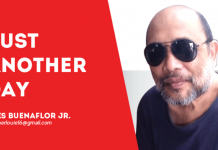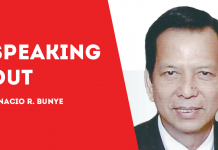BY JULIA CARREON-LAGOC
Immersion: the Sachsenhausen Concentration Camp was first in my mind. Instead, I opted for the generic title above — thinking that to be immersed is to be an active part of a crowd. To live out what they are going through, experience their ups and downs, their pains, and joys if at all. Reminds me of what unswerving, intrepid activists do — embed themselves with the deprived Juan and Juana to undergo first-hand “the short and simple annals of the poor.”
For a sharp detour, I’m putting in my kind of “immersion” inside the Marcos Detension Center at Iloilo City’s Fort San Pedro. It was like I was a political prisoner “immersed” in a stockade for most of six months in 1972-73. Our four kids — Rose, Roderick, Randy, and Raileen, ages 12 to 7, tagged along every time I would bring food and clothes to their father. A human rights lawyer, my husband Rudy was a strong critic of Ferdinand Marcos’ looming grasp of power that climaxed in the dictator’s imposition of Martial Law.
In our tour of the Baltic countries, Day 2, June 16, was scheduled for Germany, the focus of interest being the Sachsenhausen Concentration Camp. We had an excellent tour guide in Carlos Meissner, who was finishing his doctoral degree in History.
I jotted down notes as Carlos took us to the different quarters in the camp with narration of the terrifying, appalling extreme tortures perpetrated therein. It seems all the awful adjectives are never enough to condemn the inhumanities the prisoners were subjected to. Gosh, if only the walls could talk… For a thorough background, here is Wikipedia:
“The camp was established in 1936. It was located 35 kilometres (22 mi) north of Berlin, which gave it a primary position among the German concentration camps: the administrative centre of all concentration camps was located in Oranienburg, and Sachsenhausen became a training centre for Schutzstaffel (SS) officers (who would often be sent to oversee other camps afterwards).
“Executions took place at Sachsenhausen, especially of Soviet prisoners of war. Among the prisoners, there was a “hierarchy”: at the top, criminals (rapists, murderers), then Communists (red triangles), then homosexuals (pink triangles), Jehovah’s Witnesses (purple triangles), and Jews (yellow triangles).
“During the earlier stages of the camp’s existence the executions were done in a trench, either by shooting or by hanging. Sachsenhausen was originally not intended as an extermination camp — instead, the systematic murder was conducted in camps to the east. In 1942 large numbers of Jewish inmates were relocated to Auschwitz.”
Here’s Wikipedia on the most brutal, infamous Auschwitz Concentration Camp in Poland:
“Auschwitz I was first constructed to hold Polish political prisoners, who began to arrive in May 1940. The first extermination of prisoners took place in September 1941, and Auschwitz II–Birkenau went on to become a major site of the Nazi “Final Solution to the Jewish question.” From early 1942 until late 1944, transport trains delivered Jews to the camp’s gas chambers from all over German-occupied Europe, where they were killed with the pesticide Zyklon B.
“At least 1.1 million prisoners died at Auschwitz, around 90 percent of them Jewish; approximately 1 in 6 Jews killed in the Holocaust died at the camp. Others deported to Auschwitz included 150,000 Poles, 23,000 Romani and Sinti, 15,000 Soviet prisoners of war, 400 Jehovah’s Witness, homosexuals, and tens of thousands of people of diverse nationalities. Living conditions were brutal, and many of those not killed in the gas chambers died of starvation, forced labor, infections diseases, individual executions, and medical experiments.
“The prisoners were liberated on January 27, 1945, a day now commemorated as International Holocaust Remembrance Day. In the following decades, survivors such as Primo Levi, Viktor Frankl and Elie Wiesel wrote memoirs of their experiences in Auschwitz, and the camp became a dominant symbol of the Holocaust. In 1947, Poland founded a museum on the site of Auschwitz I and II, and in 1979, it was named a UNESCO World Heritage Site.”
An Elie Wiesel book in the family bookcase, I still have to read. Wiesel is a Jewish-American professor and political activist, who was 15 years old when he and his family were deported by the Nazis to Auschwitz. I have read snippets of the “Diary of Anne Frank”.
Young Anne Frank kept a diary of her experiences while in hiding from the Nazis. The movie version of the book invites watching.
Sometime in the early 2000s, Rudy and I visited our daughters who were then taking up postgraduate studies in the States. We took a tour of the Holocaust Memorial Museum in Washington, D.C., where the horrors of the genocide at the Auschwitz Concentration Camp were exhaustively depicted. The extent of man’s inhumanity to man boggled the mind, making one wonder where God was when all those atrocities were committed.
On the Museum’s Visitors’ page, I wrote these remarks: NEVER AGAIN shall the world witness another Holocaust. (juliaclagoc@yahoo.com)/PN







